
The Great Famine, also known within Ireland as the Great Hunger or simply the Famine and outside Ireland as the Irish Potato Famine, was a period of starvation and disease in Ireland from 1845 to 1852 that constituted a historical social crisis which subsequently had a major impact on Irish society and history as a whole. With the most severely affected areas in the west and south of Ireland, where the Irish language was dominant, the period was contemporaneously known in Irish as an Drochshaol, literally translated as "the bad life". The worst year of the period was 1847, which became known as "Black '47". During the Great Hunger, roughly 1 million people died and more than 1 million fled the country, causing the country's population to fall by 20–25% between 1841 and 1871. Between 1845 and 1855, at least 2.1 million people left Ireland, primarily on packet ships but also on steamboats and barques—one of the greatest exoduses from a single island in history.

The River Liffey is a river in eastern Ireland that ultimately flows through the centre of Dublin to its mouth within Dublin Bay. Its major tributaries include the River Dodder, the River Poddle and the River Camac. The river supplies much of Dublin's water and supports a range of recreational activities.
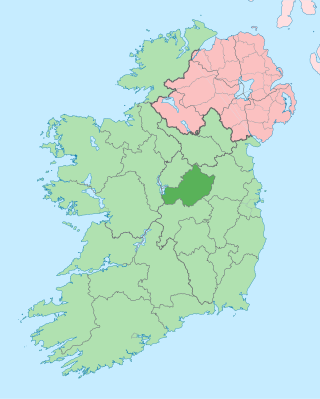
County Westmeath is a county in Ireland. It is in the province of Leinster and is part of the Eastern and Midland Region. It formed part of the historic Kingdom of Meath, which was named Mide because the kingdom was located in the geographical centre of Ireland. Westmeath County Council is the administrative body for the county, and the county town is Mullingar. At the 2022 census, the population of the county was 95,840.
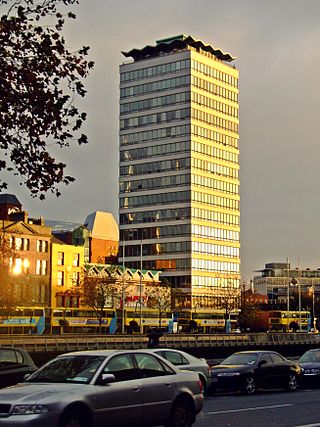
Liberty Hall, in Dublin, Ireland, is the headquarters of the Services, Industrial, Professional, and Technical Union (SIPTU). Designed by Desmond Rea O'Kelly, it was completed in 1965. It was for a time the tallest building in the country, at 59.4 metres, (195 feet) high until it was superseded by the County Hall in Cork city, which was itself superseded by The Elysian in Cork. Liberty Hall is now the fourth tallest building in Dublin, after Capital Dock, Montevetro and the Millennium Tower in Grand Canal Dock.

Dublin Port is the seaport of Dublin, Ireland, of both historical and contemporary economic importance. Approximately two-thirds of Ireland's port traffic travels via the port, which is by far the busiest on the island of Ireland.
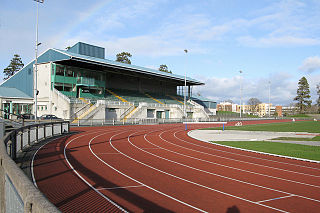
Morton Stadium, or the National Athletics Stadium, is an athletics stadium in Santry Demesne, Santry in Ireland. Often called Santry Stadium, it is the centre for athletics events in Dublin city and the home track of Clonliffe Harriers. It has also been the home ground for several Irish association football clubs including Shamrock Rovers and Dublin City. The modern capacity of the ground is 8,800, with a single 800-seat covered stand.

North Wall is an area east of the inner north side of Dublin, along the River Liffey where it forms one of the Dublin quays. It contains the entire north side of Dublin Docklands and includes the International Financial Services Centre, Spencer Dock, and further east the main part of Dublin Port.

Grand Canal Dock is a Southside area near the city centre of Dublin, Ireland. It is located on the border of eastern Dublin 2 and the westernmost part of Ringsend in Dublin 4, surrounding the Grand Canal Docks, an enclosed harbour where the Grand Canal comes to the River Liffey. The area has undergone significant redevelopment since 2000, as part of the Dublin Docklands area redevelopment project.

Rowan Fergus Meredith Gillespie is an Irish bronze casting sculptor of international renown. Born in Dublin to Irish parents, Gillespie spent his formative years in Cyprus.

Seomra Spraoi was a self-managed social centre in Dublin, Ireland which first opened in 2004 and closed in 2015. It was run on a not-for-profit basis by an anti-capitalist collective with anarchist principles.
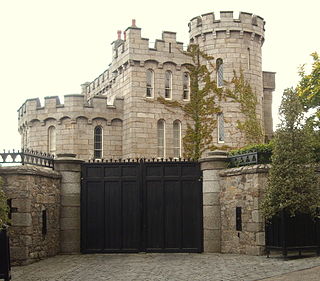
Manderley Castle, formerly "Victoria Castle" and "Ayesha Castle", is a large castellated Irish mansion built in Victorian style, in Killiney, County Dublin, Ireland. It is currently owned by the singer Enya.

Bachelors Walk is a street and quay on the north bank of the Liffey, Dublin, Ireland. It runs between Liffey Street Lower and O'Connell Street Lower and O'Connell Bridge. It was the setting for the eponymous TV series.

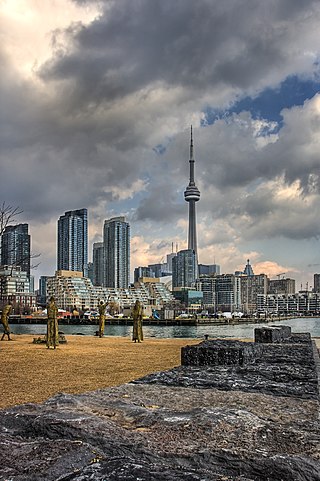
Ireland Park is located on the shores of Lake Ontario on Éireann Quay, adjoining the Canada Malting Silos, at the foot of Bathurst Street in Toronto, Ontario, Canada. Officially opened in the summer of 2007, Ireland Park commemorates the tens of thousands who fled Ireland during the Great Famine. In 1847, over 38,000 Irish men, women and children landed at Rees's Wharf on the shores of Toronto, fleeing famine and eager to start a new life. Although Toronto only had approximately 20,000 residents at the time, the city welcomed the newcomers with open arms. Over 1,100 new immigrants did not survive to make Canada their new home, with many perishing in fever sheds during the Typhus epidemic of 1847. Ireland Park is a tribute to all the Irish ancestors who came with only hope, for a new life in a promising country.
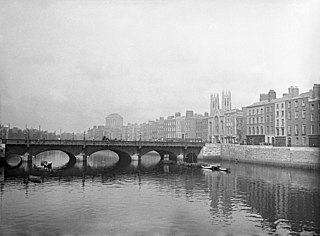
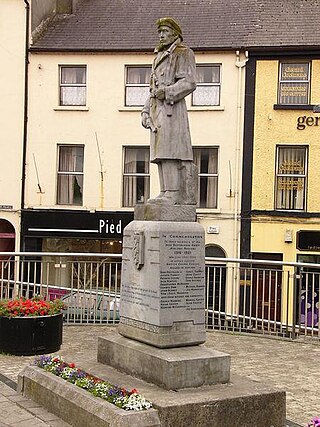
The IRA Memorial is a memorial in Athlone, County Westmeath. The memorial is dedicated to the Athlone Brigade of the Irish Republican Army that participated in the Irish War of Independence and Irish Civil War.

Hawkins Street is a street in central Dublin, Ireland. It runs south from Rosie Hackett Bridge, at its junction with Burgh Quay, for 160 metres (170 yd) to a crossroads with Townsend Street, where it continues as College Street.

















